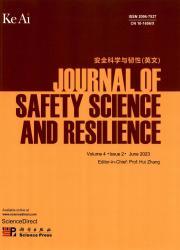Optimization of vehicle routing problems combining the demand urgency and road damage for multiple disasters
IF 3.4
Q1 PUBLIC, ENVIRONMENTAL & OCCUPATIONAL HEALTH
引用次数: 0
Abstract
In the context of the COVID-19 epidemic, a “double-hazard scenario” consisting of a natural disaster and a public health event simultaneously occurring is more likely to arise. However, compared with single-hazard, multiple disasters confront the challenges of complexity, diversity, and demand urgency. To improve the efficiency of emergency material distribution under multiple disasters, this study first divided multiple disasters into three categories: independent scenario, sequential scenario, and coupling scenario. A set of evaluation index systems for multiple disasters was established to quantify the urgency of demand. The routing optimization model of emergency vehicles for multiple disasters was proposed by combining demand urgency and road damage, and the non-dominated sorting genetic algorithm II (NSGA-II) was used to simulate and validate the model. A coupling scenario considering two typical disasters of hurricanes and epidemics was selected as a validation example, and sensitivity analysis was also performed for different algorithms, scenarios, and constraints. The results demonstrated that the proposed model could effectively address the vehicle routing problem of emergency materials in the context of multiple disasters. Compared to the NSGA, the NSGA-II was used to reduce the total delivery time, cost, and penalty cost by 15.98%, 13.60%, and 16.14%, respectively. Compared with the independent scenario, the coupling scenario increased the total delivery time and cost by 186.28% and 132.48% during the epidemic. However, it reduced the total delivery time by 4.00% and increased the delivery cost by 23.55% compared with the hurricane. Compared with the model without consideration, the model considering demand urgency and road damage reduced the total delivery time and cost by 17.88% and 8.73%, respectively. The model constructed in this study addressed the vehicle routing problem considering the demand urgency and road damage in the optimization process, particularly in the context of multiple disasters.
结合多种灾害的需求紧迫性和道路损坏情况优化车辆路线问题
在新冠肺炎疫情背景下,更有可能出现自然灾害和公共卫生事件同时发生的“双重危害情景”。然而,与单一灾害相比,多重灾害面临着复杂性、多样性和需求紧迫性的挑战。为了提高多重灾害下应急物资分配的效率,本研究首先将多重灾害分为独立情景、顺序情景和耦合情景三大类。建立了一套针对多种灾害的评价指标体系,量化了需求的紧迫性。结合需求紧迫性和道路毁损情况,提出了多灾害应急车辆路径优化模型,并采用非支配排序遗传算法II (NSGA-II)对模型进行了仿真验证。选取考虑飓风和流行病两种典型灾害的耦合场景作为验证例,并对不同算法、场景和约束条件进行敏感性分析。结果表明,该模型能够有效地解决多重灾害背景下应急物资的车辆路径问题。与NSGA相比,NSGA- ii的总交付时间、总成本和总处罚成本分别降低了15.98%、13.60%和16.14%。与独立情景相比,耦合情景在疫情期间总配送时间和总成本分别增加了186.28%和132.48%。但与飓风相比,总配送时间缩短了4.00%,配送成本增加了23.55%。与未考虑需求紧迫性和道路损坏的模型相比,考虑需求紧迫性和道路损坏的模型总交付时间和总成本分别缩短了17.88%和8.73%。本文构建的模型解决了优化过程中考虑需求紧迫性和道路损坏的车辆路径问题,特别是在多重灾害的情况下。
本文章由计算机程序翻译,如有差异,请以英文原文为准。
求助全文
约1分钟内获得全文
求助全文
来源期刊

安全科学与韧性(英文)
Management Science and Operations Research, Safety, Risk, Reliability and Quality, Safety Research
CiteScore
8.70
自引率
0.00%
发文量
0
审稿时长
72 days
 求助内容:
求助内容: 应助结果提醒方式:
应助结果提醒方式:


